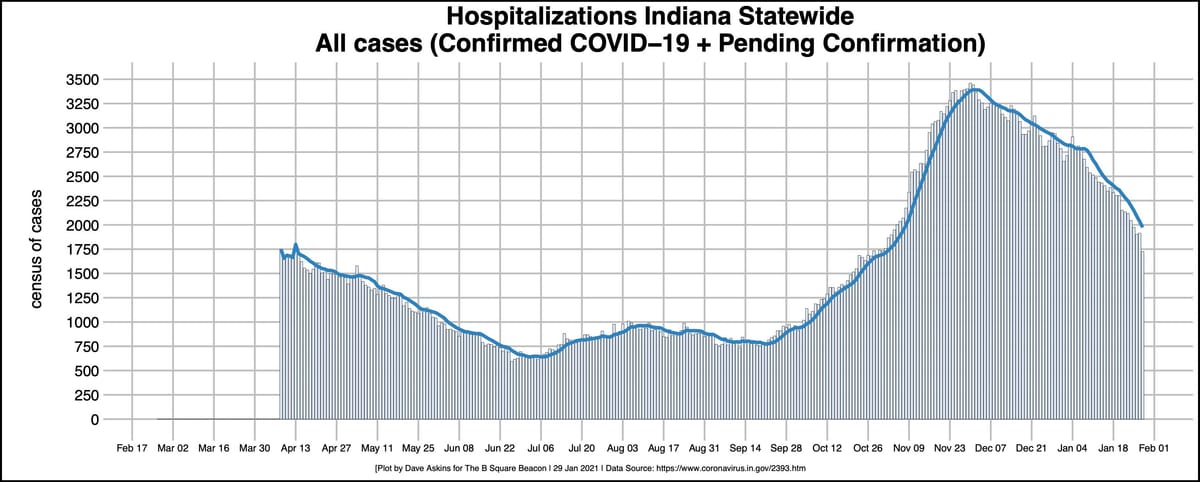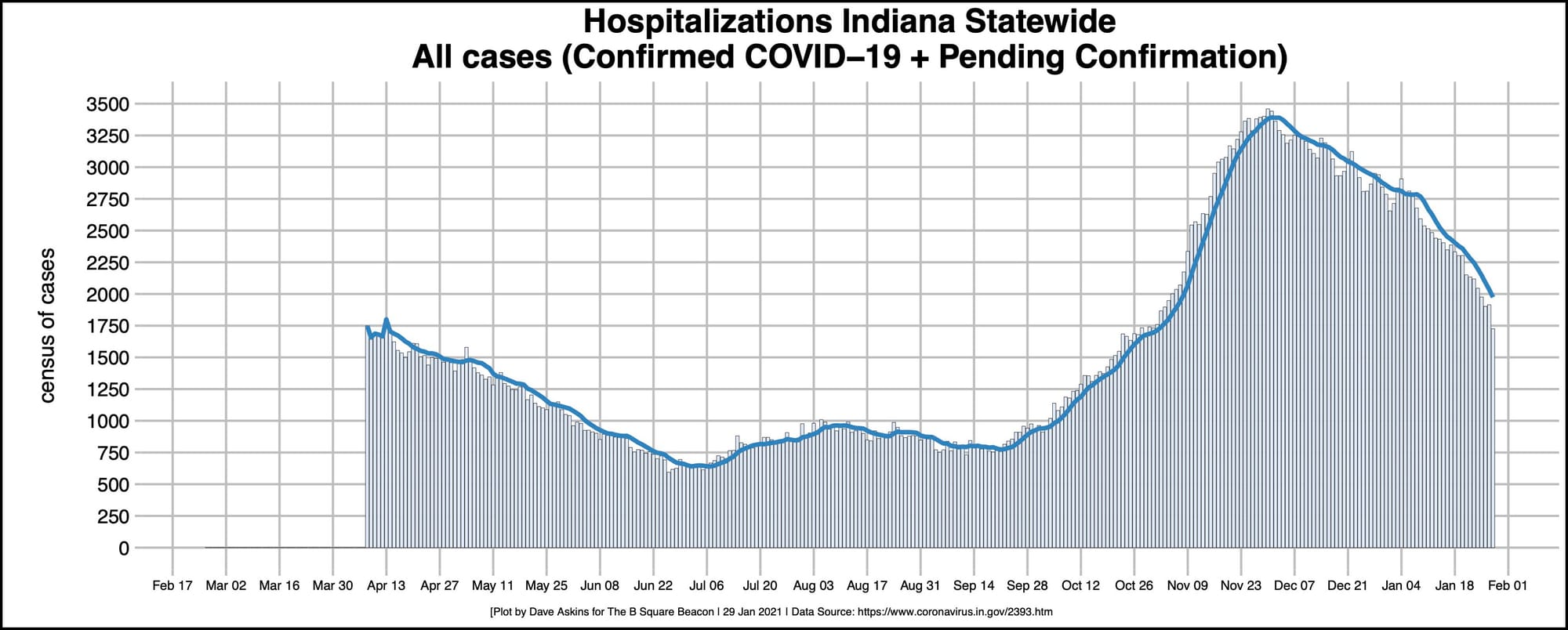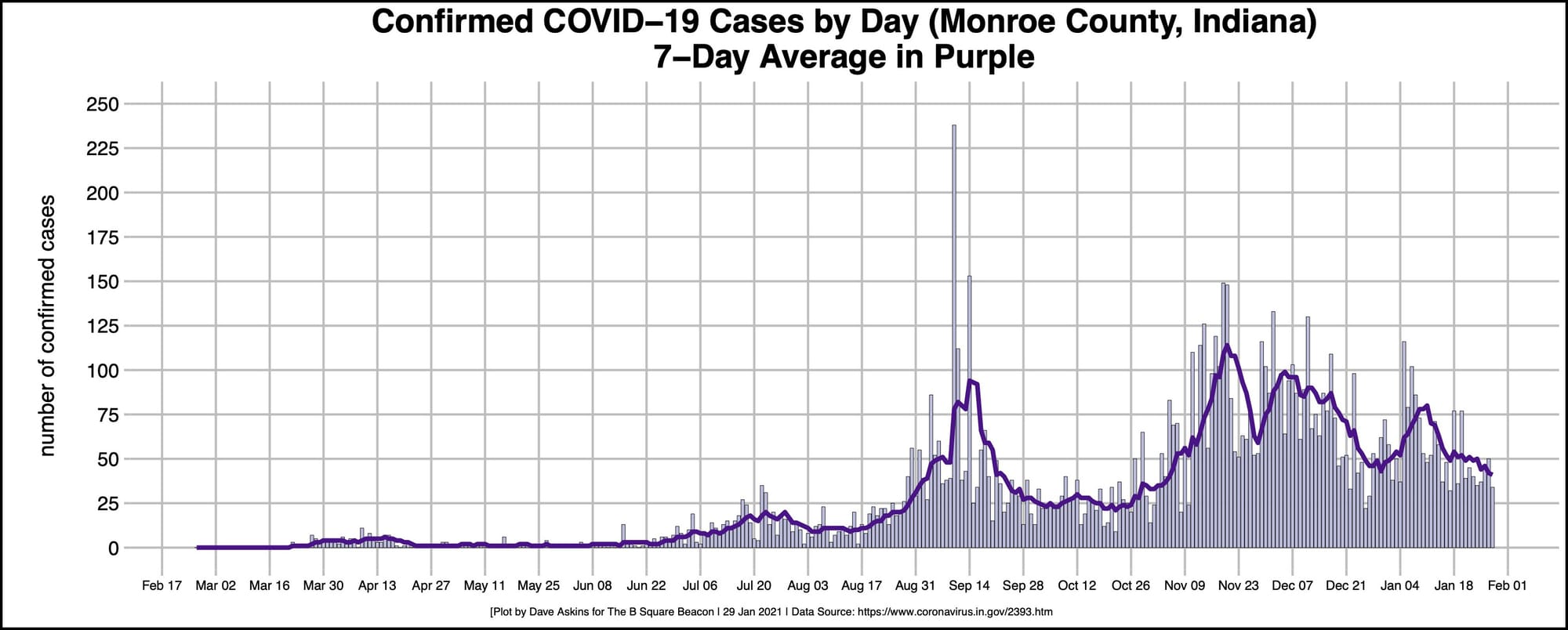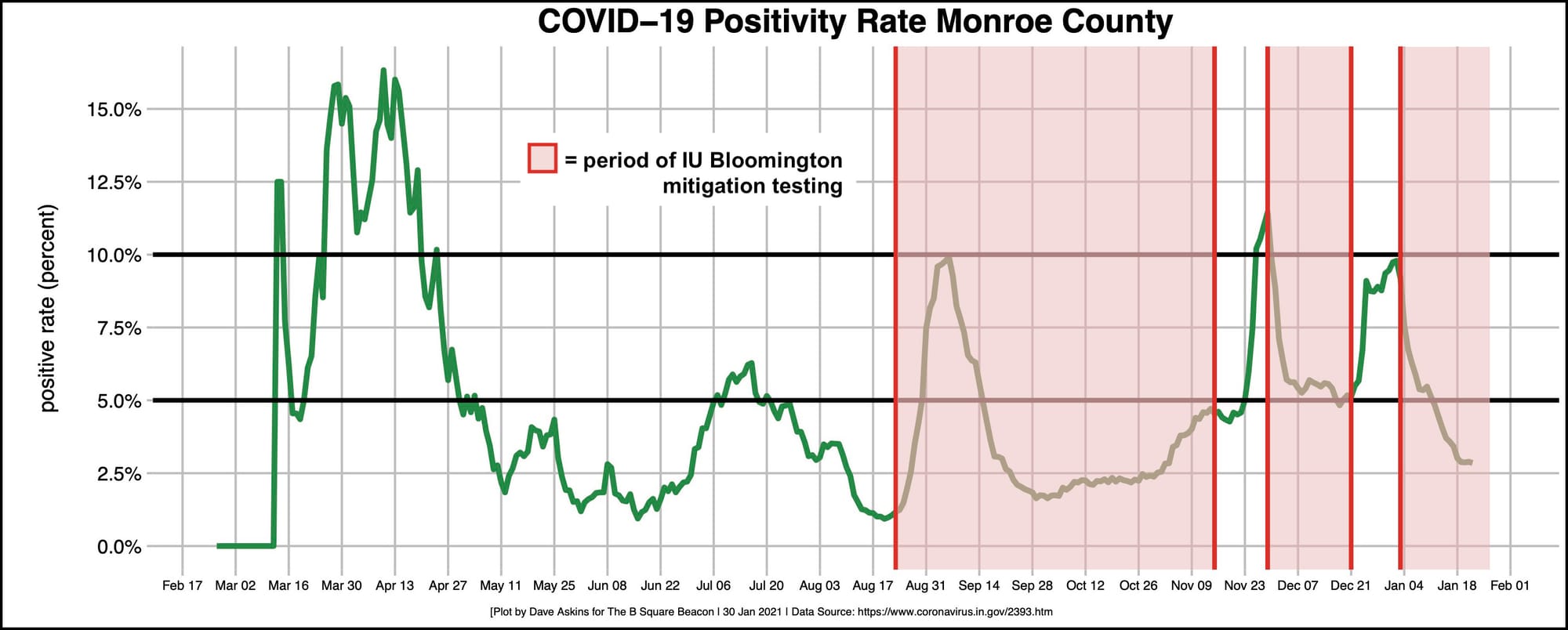Monroe County COVID-19 update: Vaccine distribution, infection rates show good relative trends, absolute picture still not ideal






Monroe County’s two COVID-19 vaccination clinics are able to deliver almost all of the vaccine they’re being allocated by the state of Indiana into the arms of the county’s residents.
That’s the latest word from Brian Shockney, president of IU Health’s south central region.
Speaking at Friday’s weekly press conference of local leaders, Shockney said that through Jan. 27, Bloomington has dispensed 14,717 of the 16,100 doses (91 percent) that have been allocated to Monroe County. By the end of Friday, Shockney said that number would rise even higher.
Shockney said on Friday, “Bloomington’s vaccine site has been outperforming every vaccine site in the IU Health system in regards to our utilization rate.” Shockney said that reflects IU Health’s commitment to making Monroe County the first county to be immunized at a high enough rate to get out of the pandemic.
Infection numbers, deaths and hospitalization are all trending down, across the state and in the county.
One of the key stats with a local trend in the right direction, and markedly better than elsewhere in the state, is the rolling average “all tests” positivity rate.
For Monroe County the positivity rate has now dropped to 2.9 percent. That is well below the 5-percent threshold that qualifies Monroe County for the best possible score on the state’s two-metric green-yellow-orange-red color-coding scheme.
Even though Monroe County’s numbers for vaccinations and positivity rates are good compared to stats from other places, in absolute terms the picture is still sobering.
At the current pace, it would take until spring 2022 to get 70-percent of Monroe County’s population vaccinated. That’s the percentage health experts say would be needed to achieve “herd immunity.”
On the other metric that is used to color-code Indiana counties, Monroe County’s current 235 cases per 100,000 residents per week gives it the worst possible score on the per capita case count.
Vaccination pace
In the five weeks that COVID-19 vaccine has been distributed in Monroe County, about 15,000 shots, counting first and second doses have been delivered, based on the state’s vaccine dashboard.
Monroe County’s 150,000 residents would need a total of 300,000 shots for everyone to be vaccinated. Seventy percent of that would be 210,000. The pace of roughly 3,000 shots a week that Monroe County has been distributing so far, puts the achievement of a 70-percent vaccination rate on a distant horizon of about 65 weeks from now, or around March 2022.
At Friday’s press conference, Bloomington’s mayor, John Hamilton said he is hopeful that the goal of vaccinating 300 million people in the US could be achieved. That’s 90 percent of the country’s population.
Hamilton pointed to the purchase of more vaccine planned by the Biden administration—200 million more doses by the end of March, 200 million more by the end of June, and another 200 million doses by late summer.
The current pace of vaccination is not just better in Monroe County than elsewhere in the state, it’s better in Indiana than in the rest of the country, according to Shockney.
Shockney said, “Indiana is leading the country in the percentage of the population fully vaccinated, at 0.99 percent.” Shockney gave credit for that result to Indiana’s health commissioner, Kris Box, and the health department’s chief medical officer, Lindsay Weaver.
Right now, the main barrier to vaccination is the amount of available vaccine. Eventually, the willingness of people to get vaccinated could become a limiting factor in what percentage of the population is vaccinated.
Bloomington’s mayor, John Hamilton, was asked at Friday’s press conference if the city of Bloomington might consider posting publicly its employee vaccination numbers, broken down by department. That’s what the city has done for employee infections, in a table that’s included on its COVID-19 webpage along with other information.
Hamilton response: “It’s a good question. Let me check on that. I’m not sure whether we will have exactly all that data the same way we do for reporting of any positive case.” He added, “But I think it’s a really good question. I’ll get back to you next week.”
Positivity rate, mitigation testing
Monroe County’s positivity rate—the percentage of tests that are positive—is just 2.9 percent. That is well below the 5-percent threshold that qualifies Monroe County for the best possible score on the state’s two-metric green-yellow-orange-red color-coding scheme.
On the other metric that is used to color-code Indiana counties, Monroe County’s current 235 cases per 100,000 residents per week gives it the worst possible score on the per capita case count.
Monroe County would need to reduce its per capita weekly case count by 35 just to get to the second-worst score.
How can Monroe County have the worst score on per capita cases, but the best score on positivity rate?
Part of the reason is the large number of mitigation tests that are done in the county. Indiana University has been doing large numbers of mitigation tests, which are done on randomly selected people to study how the virus is spreading.
A mitigation test contrasts with a test that someone gets for a specific reason—they have symptoms, or think they have been exposed to someone with the disease, or want a test for some other reason.
For the same population, mitigation tests generally show a lower percentage of positive cases than other tests.
For the week of Jan. 17, the state dashboard records 12,680 tests in all of Monroe County. For the same week, IU’s dashboard shows 11,484 mitigation tests.
For that week, it means 90 percent of Monroe County tests were mitigation tests.
For the week of Jan. 17, the mitigation test positivity rate was 0.28 percent. The relatively large number of mitigation tests, combined with their low positivity rate—pushes down the overall positivity rate for the county.
After starting in August, IU has taken two 2-week breaks from mitigation tests for the holidays. Plotting Monroe County’s positivity rate over time, highlighting the spans when mitigation tests were done, shows the arithmetic impact of mitigation tests.
In the first three weeks when the mitigation tests were implemented, in August, their positivity rate was between 3 and 6 percent, which was higher than the Monroe County average was in the weeks leading up to that point.
At Friday’s news conference, Monroe County health administrator Penny Caudill said she did not have positivity numbers for the community testing site or the one operated by OptumServe, but said the trend was downward.
At the same time, Caudill recognized the role that the university’s mitigation testing plays in pushing the local number down: “I think that our positivity rate, we know, is coming down, in part because of the high number of tests that IU does. But we’re also seeing similar things in our community.”
Across the state of Indiana, the positivity rate is trending down. At the start of 2021 Indiana’s positivity rate was around 16 percent and in the last three weeks it has dropped to about half that.





Comments ()